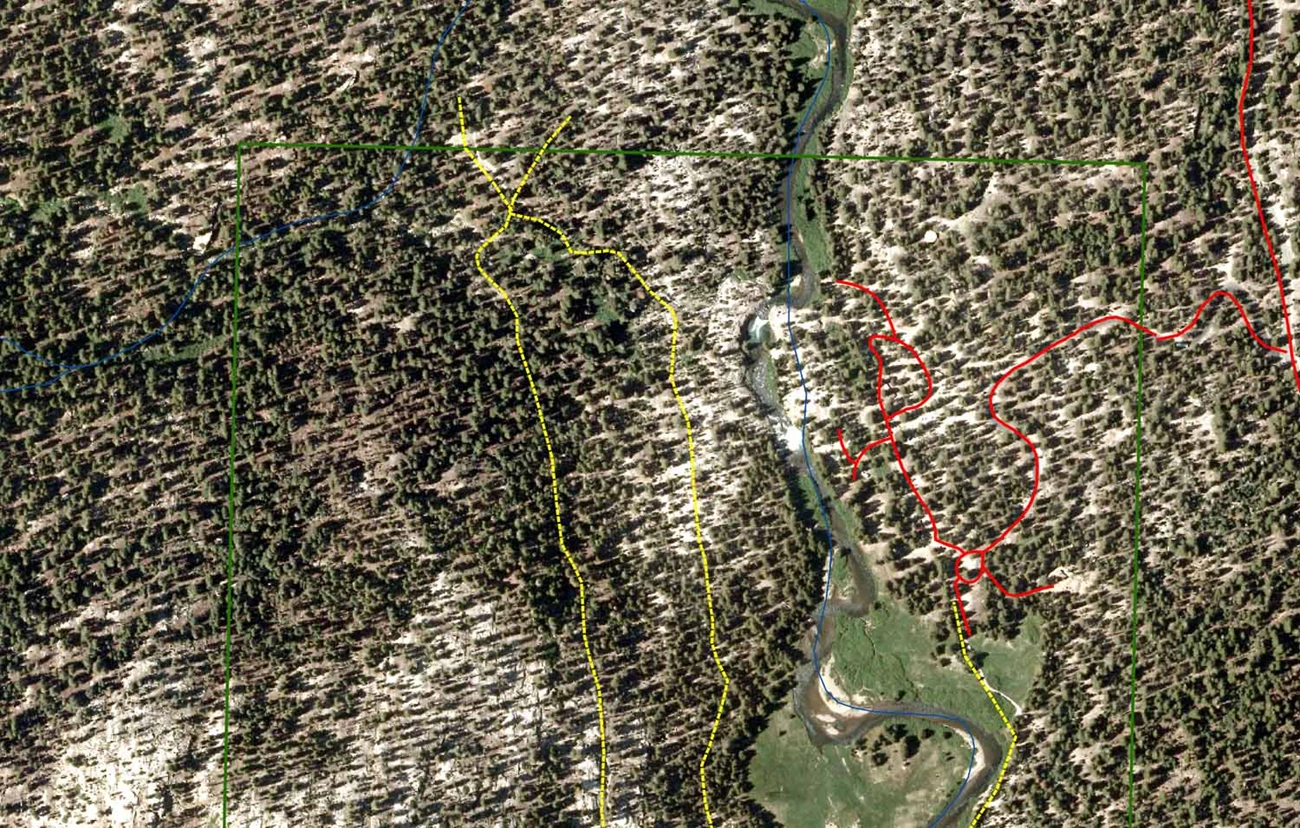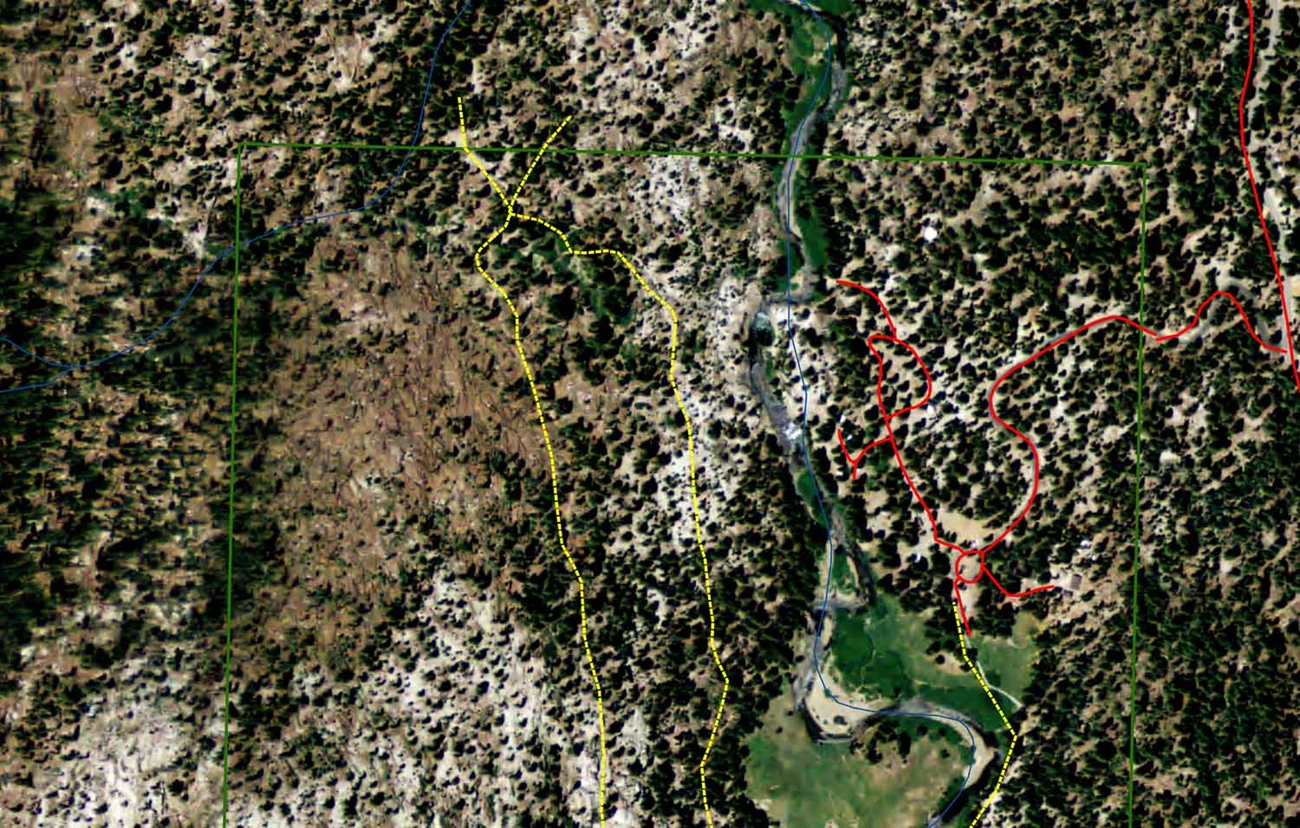Last updated: December 20, 2023
Article
Windstorm Effects on Conifer Forests of Devils Postpile National Monument
Introduction
An unusual wind event affected significant portions of the southern Sierra Nevada November 30 to December 1, 2011. The wind event was caused by an extreme pressure gradient from north to south over Nevada and the Sierra Nevada and was unusual for the region in three ways: 1) long duration, 2) atypical wind direction, and 3) high intensity wind. Extreme wind speeds lasted for 12 hours, from 6 pm to 6 am, with strongest winds occurring from 10 pm to 4 am. An anemometer at Mammoth Mountain, California recorded winds that exceeded 145 km/hour, with a predominantly NNE direction. Extensive windthrow of trees occurred in Devils Postpile National Monument and other areas of the Sierra Nevada (Figure 1). The wind event is the most extensive on record for California’s Sierra Nevada range and may have long lasting impacts on forest composition and function.


Left image
Pre-blowdown image, taken in 2010
Credit: National Agricultural Imagery Program of the USDA, edited by Anthony Caprio.
Right image
Post-blowdown 2012 image of the northwest portion of Devils Postpile National Monument. Note the extensive loss of trees west of the trail.
Credit: National Agricultural Imagery Program of the USDA, edited by Anthony Caprio.

NPS / Anthony Caprio
Characterizing Windthrown Trees
Scientists conducted a study in May 2012 to characterize the attributes of windthrown trees in a Devils Postpile mixed-conifer forest (Hilimire et al. 2013). The forest is composed primarily of red fir (Abies magnifica), white fir (Abies concolor), and lodgepole pine (Pinus contorta). Study objectives were to:
- Understand the relationship between tree size and wind damage,
- Assess factors associated with uprooting versus snapping caused by wind, and Compare vulnerability by species of the windthrow by assessing species composition of the forest pre- and post-blowdown.
To assess the effects of fire on forest ecosystem processes, a set of eight fire effects monitoring plots had been installed in 1992 following the Rainbow Falls fire; these plots were re-measured in 2002 and an additional two unburned plots were installed in 2005. These data included 390 live trees, which were used to assess pre-blowdown forest structure and composition. These plots also provided photo points where repeat photos could be taken to illustrate localized effects of tree blowdown (Figures 2 and 3). In addition, 13 100-meter long transects were established in May 2012, and new windthrown trees along these transects were characterized. Data were collected on density, fall angle, type of damage, and species composition and abundance of windthrown trees.


Left image
Figure 3A. Fire effects plot (unburned) photographed in 2005, Devils Postpile National Monument..
Credit: NPS / Sequoia & Kings Canyon National Parks Fire Effects Program.
Right image
Figure 3B. Photo of the same fire effects monitoring plot six months after the blowdown, showing two trees uprooted.
Credit: NPS / Sequoia & Kings Canyon National Parks Fire Effects Program.
Results and Discussion
Windthrown trees had a mean density of 119 trees per kilometer along the 13 transects. Mean fall angle was strongly SSW (Figure 4). Average windthrown tree diameter was 2.2 times larger than that of pre-windstorm standing trees (55.36 cm and 24 cm respectively). Damage type varied: 86% of trees were uprooted and 14% were snapped. Standing live trees were far more likely than dead trees to uproot than snap. There was not a strong difference among the tree species in their susceptibility to damage type. The species composition and abundance of windthrown trees was representative of pre-blowdown stand composition and abundance.

Photo by Kathleen Hillimire
These results are consistent with other studies that documented a strong relationship between tree size and amount of damage from windstorms. By primarily affecting larger trees, windstorms are likely to have different impacts on forest regeneration and function than other disturbances such as fire.
Uprooting was the most common type of damage. Various factors such as precipitation, stem rot, tree status (living or dead), slope, and stem size are related to whether a stem is uprooted or snapped. The type of damage has important ecological implications for wildlife and forest regeneration. Uprooting can create mounds of exposed soil that can facilitate seedling establishment, while snapping can create dead snags that are important to wildlife such as cavity nesting birds.
This study describes the forest stand at time zero after an unusual windstorm. It will be important to continue to monitor how this event affects forest structure and diversity in future years.
Reference
Hilimire, K., J. C. B. Nesmith, A. C. Caprio, and R. Milne. 2013. Field Note: Attributes of Windthrown Trees in a Sierra Nevada Mixed-conifer Forest. Western Journal of Applied Forestry 28(2): 85-88.
More Information
For a printable resource brief, visit this record in the Integrated Resource Management Applications online database, and use the download link.For more information about Devils Postpile National Monument, visit this web page.
